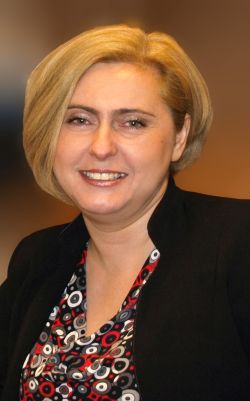CME 2024 programme contains:
- Plenary lectures
- Working seminars
- Research reports
- Workshops
- Poster session
CME 2024 plenary speakers
- Mirosława Sajka
Department of Mathematics
University of the National Education Commission in Krakow
Poland

Educational resources in mathematics – the interplay between research and school practice
Abstract: Negative numbers, algebraic expressions and functions are among the most fundamental mathematical topics and, at the same time, cause many difficulties for students, therefore they require well-planned didactic approaches and well-prepared educational resources in the mathematics classroom. In this talk, I will present approaches developed during my studies on these issues. Firstly, an algebraic approach towards shaping the notion of ‘minus’ in school mathematics will be presented in the context of both negative numbers and algebraic expressions. This approach has its origins in historical research on the emergence of the concept of negative numbers in two theoretical models. One of them is more elementary, so its didactic model will be provided in the form of tokens, which is extended for the purpose of teaching basic algebraic expressions. The evaluation of this approach will be also discussed. Secondly, the enhancement of covariational functional thinking in secondary school students will be discussed. Covariational thinking can be introduced to students in the early years of mathematics, whereas in secondary school, where we introduce and use the concept of function, the implementation of covariational functional thinking in mathematics teaching is sometimes neglected in favour of the other aspects of functions, such as: function as input-output assignment, correspondence and mathematical object. However, covariational functional thinking is essential for understanding differential calculus, but also for solving modelling problems. Based on empirical research using methodological triangulation, including the use of eye-tracking, I will present the difficulties diagnosed in students’ covariational functional thinking, including understanding, interpreting and using graphs of functions in the context of motion analysis. I will then outline the educational resources that have been developed to prevent such deficiencies and to support covariational functional reasoning.
- Chrysanthi Skoumpourdi
Department of Pre-school Education and Educational Design
University of the Aegean
Greece

The pathways of ‘additional’ educational materials up to the mathematics classrooms
Abstract: The teaching and learning of mathematics, due to its abstract nature, are enhanced through the utilization of provided or/and ‘additional’ educational materials. The wide variety of the available ‘additional’ mathematics’ educational materials requires teachers to take specific decisions for the designed integration of these materials in their teaching practice. The definition of the concepts of provided and ‘additional’ educational materials (AEM), the reflection of educators’ decisions on the position of these educational materials in the mathematics classroom, as well as the determination of the relationship between teachers, students, and AEM are issues that will be discussed both theoretically and practically, through specific examples. Investigating the above pathways that AEM could follow, up to the mathematics classrooms, as fundamental aspects of their designed integration, one can recognize their multidimensional relationship with teachers, as well as the learning opportunities they may (or may not) offer to students.
- Daniel Walter
TU Dortmund University
Germany

Potentials of digital educational resources in the mathematics classroom – didactical considerations and empirical findings
Abstract: Digital media are increasingly finding their way into classrooms as educational resources – also with regard to mathematics lessons in primary schools. A vitalized discussion about the potentials and limitations of digital media for learning in schools can be observed in the scientific community. However, the question of how digital media can be used beneficially and subject-related is by no means new. Back in 1981, Freudenthal already formulated thirteen major problems of mathematics education, including the following: „How can calculators and computers be used to arouse and increase mathematical understanding?” Although more than four decades have passed since then and a number of positive examples on the use of digital media are certainly available, it can be stated retrospectively that the integration of digital media has not yet been as successful as one might have hoped.The reasons for this can certainly be manifold: from organizational aspects such as the provision of suitable infrastructure to didactic aspects and the availability of adequate digital learning opportunities and appropriate teaching concepts. In order to specifically address concepts for teaching and learning mathematics with digital media, I will focus on subject-specific potentials that arise primarily through the availability of digital media. I will first illustrate these potentials using examples and then use empirical studies to discuss how they are used by learners.
